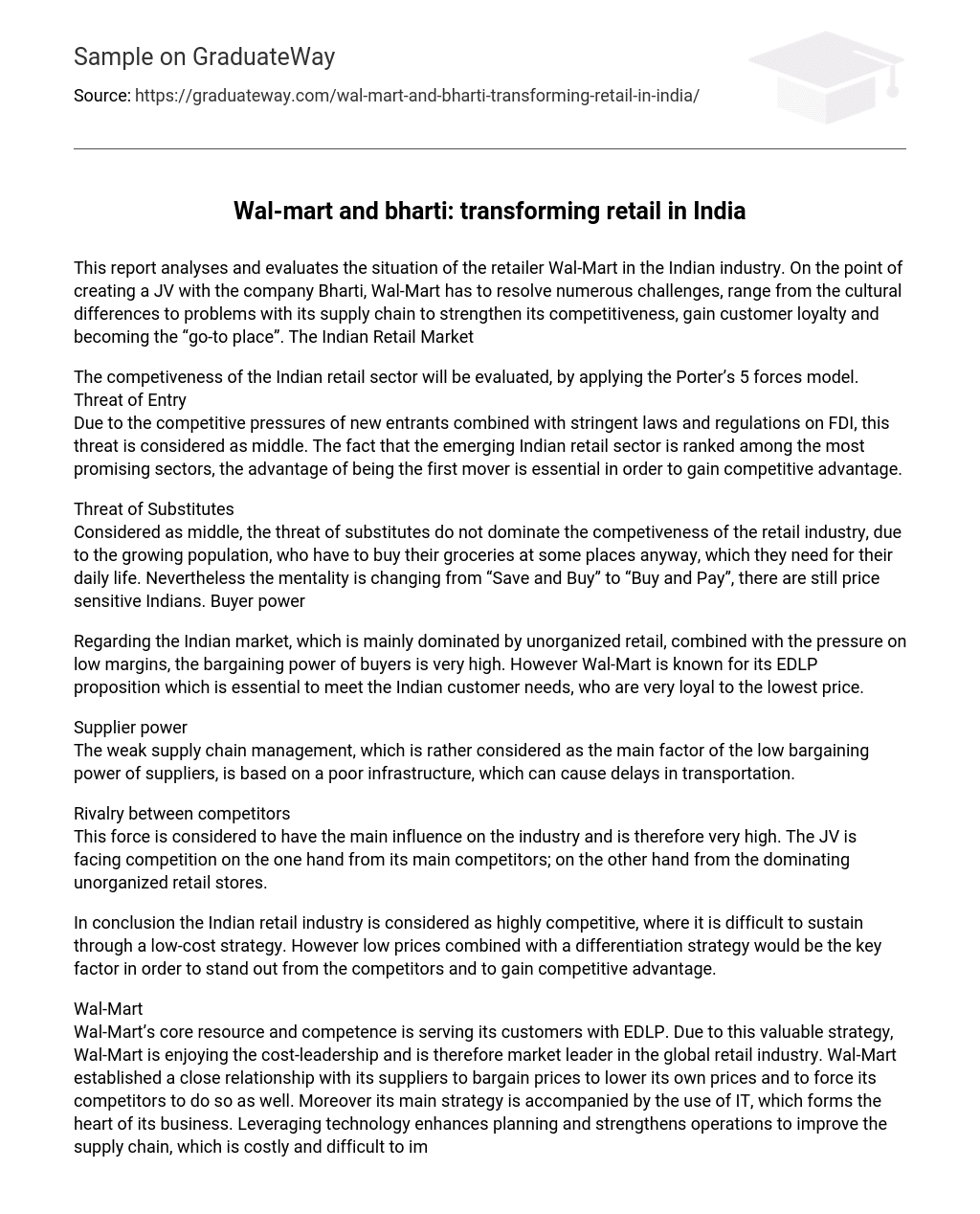This report analyses and evaluates the situation of the retailer Wal-Mart in the Indian industry. On the point of creating a JV with the company Bharti, Wal-Mart has to resolve numerous challenges, range from the cultural differences to problems with its supply chain to strengthen its competitiveness, gain customer loyalty and becoming the “go-to place”. The Indian Retail Market
The competiveness of the Indian retail sector will be evaluated, by applying the Porter’s 5 forces model.
Threat of Entry
Due to the competitive pressures of new entrants combined with stringent laws and regulations on FDI, this threat is considered as middle. The fact that the emerging Indian retail sector is ranked among the most promising sectors, the advantage of being the first mover is essential in order to gain competitive advantage.
Threat of Substitutes
Considered as middle, the threat of substitutes do not dominate the competiveness of the retail industry, due to the growing population, who have to buy their groceries at some places anyway, which they need for their daily life. Nevertheless the mentality is changing from “Save and Buy” to “Buy and Pay”, there are still price sensitive Indians. Buyer power
Regarding the Indian market, which is mainly dominated by unorganized retail, combined with the pressure on low margins, the bargaining power of buyers is very high. However Wal-Mart is known for its EDLP proposition which is essential to meet the Indian customer needs, who are very loyal to the lowest price.
Supplier power
The weak supply chain management, which is rather considered as the main factor of the low bargaining power of suppliers, is based on a poor infrastructure, which can cause delays in transportation.
Rivalry between competitors
This force is considered to have the main influence on the industry and is therefore very high. The JV is facing competition on the one hand from its main competitors; on the other hand from the dominating unorganized retail stores.
In conclusion the Indian retail industry is considered as highly competitive, where it is difficult to sustain through a low-cost strategy. However low prices combined with a differentiation strategy would be the key factor in order to stand out from the competitors and to gain competitive advantage.
Wal-Mart
Wal-Mart’s core resource and competence is serving its customers with EDLP. Due to this valuable strategy, Wal-Mart is enjoying the cost-leadership and is therefore market leader in the global retail industry. Wal-Mart established a close relationship with its suppliers to bargain prices to lower its own prices and to force its competitors to do so as well. Moreover its main strategy is accompanied by the use of IT, which forms the heart of its business. Leveraging technology enhances planning and strengthens operations to improve the supply chain, which is costly and difficult to imitate. Based on its EDLP Strategy, which requires efficient processes, Wal-Mart stands out from its competitors and is enjoying sustained competitive advantage.
Wal-Mart Bharti Joint-Venture
Regarding the future venture of Bharti, Wal-Mart will have to deal with numerous challenges range from strict laws and regulations to cultural differences. The SWOT analysis below will evaluate how well Bharti will fit into Wal-Mart’s operating plan. Strengths
Bharti has grown the last few years by building global partnership. Its high presence in India combined with its deep knowledge of the growing consumer market can help to extend WalMart’s retail expertise. It has built a huge network of suppliers and business partners which will be useful for the JV.
Weaknesses
Compared to Wal-Mart Bharti is a small company, which could lead to an imbalance of power. Moreover its experience in retail is very limited. The JV will require a lot of co-operating and cross cultural management.
Opportunities
The change from a S&B to B&P mentality, accompanied with an enhancement of the living conditions let the Indian retail market boom. Moreover the growing number of working youth and women leads to increased consumer spending and purchasing power. However Indian consumers still attach importance to lower prices.
Threats
Wal-Marts poor social image as well as the strict labour laws and regulations on FDI can be serious issues. The poor infrastructure will cause a lot of problems, when implementing WalMart’s efficient supply chain. Moreover already established retail companies and new entrants will make it more difficult for the JV to sustain in this highly competitive industry.
Recommendation
Based on the analysed facts, I deduced two main options open to the JV: Whether entering the Indian market or not. Not entering the Indian market is justified by the enormous number of threats and weaknesses in the retail industry. This option would include avoiding businesses within India and cooperating with a company that has more expertise in retail. There are other markets with less regulations and customers who are still demanding low prices. Entering the Indian market will be a very risky and costly strategy. In order to succeed WalMart has to focus on its core competences as well as on differences in consumer behaviour. Beside the low-price strategy, consumer demands a favourable price-quality ratio. Thereby Wal-Mart has to redefine its current strategy by focusing on differentiation and keeping low prices.
Considerable amounts of money will be necessary to invest in the poor infrastructure in order to implement its sufficient supply chain. Due to the tremendous importance of respecting the Indian culture, Wal-Mart needs to establish social actions by implementing CSR. On the one hand Wal-Mart should adjust its supply chain towards an environment–friendly management; on the other hand a positive relationship with the community is crucial, by using local producers and stimulating the local economies. CSR can improve the reputation of the company enormously. A high reputation combined with the sufficient supply chain and a favourable price-quality ratio, can push the JV ahead.
In conclusion, I would recommend Wal-Mart to enter the Indian market, while improving its core competences and implementing CSR, which are creating a sustained competitive advantage and thus leads to a strengthened competitiveness.





